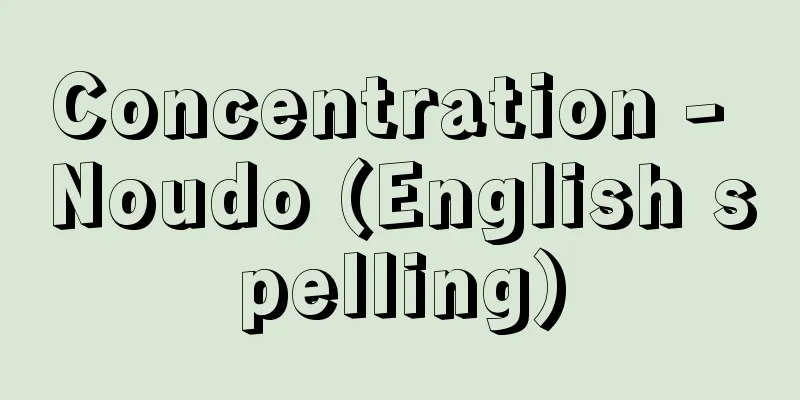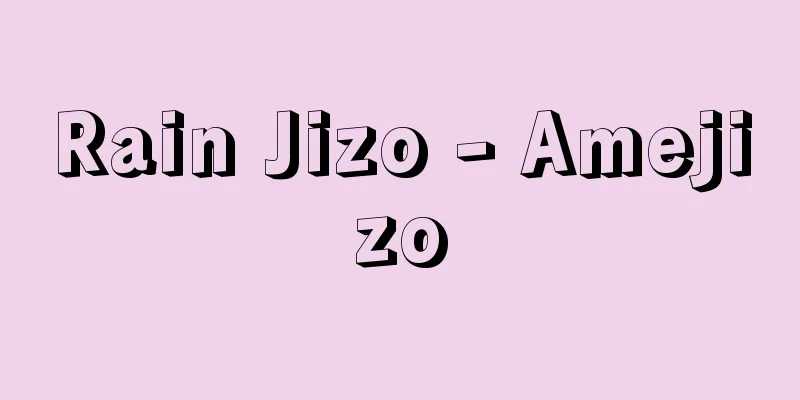Concentration camp - Konzentrationslager (English spelling) German

|
Unlike regular prisons, prison camps, or refugee camps, this refers to facilities where large numbers of citizens are forcibly detained without trial for political reasons. The name comes from the detention facilities established by Spain during the Cuban Revolt in 1896, and it is well known that in the Boer War of 1901, Britain detained and abused 120,000 Boers to suppress guerrilla movements. The most famous are the concentration camps of Nazi Germany, but the term is sometimes used more broadly to include the Soviet labor camps and the camps for Japanese citizens in the United States during World War II. [Teruo Yoshida] Nazi GermanyHere, an exceptional legal emergency decree was issued (February 28, 1933) on the pretext of the Reichstag arson incident, allowing the police, SA and SS to preventively detain Communists and other political opponents, and Himmler established the first concentration camp in Dachau, on the outskirts of Munich. Since 1934, the concentration camps have been under the control of the SS, and in 1935 their purpose was expanded to include the elimination of all people who were considered "vermin" for ideological, racial or social reasons (clergy, Jews, work-averse people, habitual criminals, homosexuals, etc.). At first, the purpose was social isolation or correction, but after 1938, the essential purpose became forced labor in the munitions industry. With the start of World War II, the number of camps increased, and citizens of occupied territories began to be detained. In 1944, there were 20 concentration camps and 165 labor camps attached to them, with a total of 710,000 inmates (5-10% of whom were German). After 1941, when the so-called "Final Solution" of the Jewish problem began, Auschwitz (Oświęcim) and other places were turned into extermination camps, where 6 million Jews and 500,000 non-Jews were killed. Concentration camps were an essential component of the Nazi ruling system, but they did not exist in Fascistic Italy. [Teruo Yoshida] USSRSince the imperial era, political prisoners had been subjected to forced labor, but when the Russian Revolution occurred, "class enemies" such as counter-revolutionaries and serious economic criminals were detained, and during the Five-Year Plans, "rich peasants" were detained, and many more people were detained during the "purges" and when the Soviet Union expanded its territory after 1939, the total number of whom is said to have reached 5 million. The purpose was supposed to be re-education through labor, but it cannot be denied that forced labor here played a certain role in the Soviet economy. [Teruo Yoshida] AmericaWhen the war between Japan and the United States began in 1941, President Roosevelt, fearing "fifth column" (spy) activity, quarantined 110,000 Japanese citizens on the West Coast of the United States, a measure that was recognized by Congress and the Supreme Court as a "military necessity" (it is said that the Canadian government also took similar measures). However, no such measures were taken against Japanese citizens in the eastern United States or Hawaii. [Teruo Yoshida] Situation since World War IIIt is said that during the Mau Mau uprising in Kenya in the 1950s, the UK urgently detained 80,000 people, and there have been rumors of the existence of camps for political prisoners in communist countries, as well as in Greece under the former military regime, and the Chilean military regime, but the actual situation is unclear. [Teruo Yoshida] "Beyond 'Night and Fog' - Survivors of the Polish Concentration Camps" by Yoshino Oishi (1988, NHK Publishing Association)" ▽ "Topaz Times, Newspaper from the Japanese-American Concentration Camps, Volumes 1-10 (1990, Japan Library Center)" ▽ "Fragments of Life - 20 Years in the Soviet Concentration Camps" by Jack Rossi, translated by Tsuguo Togawa, commentary by Gosuke Uchimura (1996, Seibunsha)" ▽ "Nazi Concentration Camps - From Their Birth to Liberation" by Kimiaki Hasegawa (1996, Soshisha)" ▽ "Topaz Diaries - Japanese-American Children of Concentration Camps" by Michael O. Tanner et al., translated by Chikako Takeshita (1998, Kin no Hoshi Sha)" ▽ "The SS State - The System of German Concentration Camps" by E. Kogon, translated by Kozo Hayashi (2001, Minerva Shobo)" ▽ "Postwar History of German Psychopathology: Concentration Camp Experiences and Postwar Compensation" by Kazuichiro Omata (2002, Gendaishokan) [References] | | | | |A concentration camp built by Nazi Germany during World War II. It is now a museum, and the starvation chambers and gas chambers remain. World Heritage Site "Auschwitz-Birkenau: Nazi Germany's Concentration and Extermination Camp (1940-1945)" (Poland, registered in 1979) Poland Oświęcim ©Shogakukan "> Auschwitz Concentration Camp Source: Shogakukan Encyclopedia Nipponica About Encyclopedia Nipponica Information | Legend |
|
通常の刑務所や捕虜収容所、難民収容所などと異なり、政治的理由から裁判によることなく多くの市民を強制的に収容する施設をいう。この名称は、1896年スペインがキューバ反乱の際に設けた抑留施設に由来し、1901年ブーア戦争でイギリスがゲリラ鎮圧のため12万人のブーア人を収容し虐待したことはよく知られる。有名なのはナチス・ドイツの強制収容所で、一般にはこれをさすが、ソ連の労働収容所、第二次世界大戦中のアメリカの日系市民収容所などを含めて広くいう場合もある。 [吉田輝夫] ナチス・ドイツここでは国会放火事件を口実に例外法的緊急令が出され(1933年2月28日)、警察、突撃隊、親衛隊は共産主義者などの政敵を予防拘禁できるようになり、ヒムラーは最初の強制収容所をミュンヘン郊外ダッハウに設けた。1934年以来強制収容所は親衛隊の管理下に置かれるが、その目的も35年にはイデオロギー的・人種的・社会的理由から「国民の害虫」とされたあらゆる人々(聖職者、ユダヤ人、労働忌避者、常習犯、同性愛者など)の排除に拡大された。初めは社会的隔離ないし矯正を目的としたが、38年以後は軍需産業での強制労働が本質的目的となった。第二次世界大戦が始まると、収容所数も増え、占領地域の市民が収容されるようになった。44年には、強制収容所20、これに付属する労働収容所165、収容者数71万(うちドイツ人は5~10%)であったといわれる。41年以後いわゆるユダヤ人問題の「最終的解決」が始まると、アウシュヴィッツ(オシフィエンチム)などは絶滅収容所となり、600万のユダヤ人、50万の非ユダヤ人がここで殺害された。強制収容所はナチス支配体制の本質的構成要素であったといえるが、ファッショ・イタリアには存在しなかった。 [吉田輝夫] ソ連帝政期以来、政治犯は強制労働を課されたが、ロシア革命が起こると、反革命分子、重大な経済犯などの「階級敵」が収容され、五か年計画時には「富農」が、さらに「粛清」時に、また1939年以後の領土の拡大時に多くの人々が収容され、その数は500万人に上ったといわれる。その目的は労働による再教育とされたが、ここでの強制労働がソ連経済に一定の役割を果たしたことは否定できない。 [吉田輝夫] アメリカ1941年日米戦争が始まると、大統領ルーズベルトは「第五列」(スパイ)的活動を恐れ、アメリカ西海岸の日系市民11万人を集中隔離し、議会や最高裁もこの措置を「軍事的必要」として認めた(カナダ政府も同様な措置をとったといわれる)。だが、アメリカ東部やハワイの日系市民にはこのような措置はとられなかった。 [吉田輝夫] 第二次世界大戦以降の状況1950年代ケニアでのマウマウ団の乱に際しイギリスは8万人を緊急収容したといわれるし、共産圏諸国あるいはかつての軍事政権下のギリシアや、チリの軍事政権などについても政治犯の収容所の存在がささやかれたが、実態は明らかでない。 [吉田輝夫] 『大石芳野著『「夜と霧」をこえて――ポーランド・強制収容所の生還者たち』(1988・日本放送出版協会)』▽『『日系人強制収容所新聞「トパーズ・タイムズ」』第1~10巻(1990・日本図書センター)』▽『ジャック・ロッシ著、外川継男訳、内村剛介解題『さまざまな生の断片――ソ連強制収容所の20年』(1996・成文社)』▽『長谷川公昭著『ナチ強制収容所――その誕生から解放まで』(1996・草思社)』▽『マイケル・O・タンネルほか著、竹下千花子訳『トパーズの日記――日系アメリカ人強制収容所の子どもたち』(1998・金の星社)』▽『E・コーゴン著、林功三訳『SS国家――ドイツ強制収容所のシステム』(2001・ミネルヴァ書房)』▽『小俣和一郎著『ドイツ精神病理学の戦後史――強制収容所体験と戦後補償』(2002・現代書館)』 [参照項目] | | | | |第二次世界大戦時にナチス・ドイツによってつくられた収容所。現在は博物館となっており、餓死室、ガス室などが残されている。世界文化遺産「アウシュヴィッツ‐ビルケナウ:ナチス・ドイツの強制絶滅収容所(1940―1945)」(ポーランド・1979年登録) ポーランド オシフィエンチム©Shogakukan"> アウシュヴィッツ強制収容所 出典 小学館 日本大百科全書(ニッポニカ)日本大百科全書(ニッポニカ)について 情報 | 凡例 |
<<: Administrative scrivener - Gyoseishoshi
>>: Administrative Guidance - gyousei shido
Recommend
The Society for Diligence and Frugality
...It began with Mao Zedong's instruction to ...
Glossarium ad scriptores mediae et infimae latinitatis
…At the age of 47, he published his first work, t...
Combining
...(4) Slicing: A continuous string-like sliver i...
Kisaragisha - Kisaragisha
…While continuing to teach at his alma mater, he ...
Ahmad Shah
1898‐1930 The seventh Shah of the Qajar dynasty. R...
Raft - raft
A boat made of buoyant materials such as wood, ba...
Enshu Railway Co., Ltd.
Official company name: Enshu Railway Co., Ltd. Com...
Durbin-Watson ratio
It is one of the statistics to test whether there ...
Omagasaki - Omagasaki
Also called "Oma." In the Heian period, ...
Red Volta - Akaboruta
…Its basin area is about 400,000 km2. The upper r...
Phormiōn (English spelling)
[raw]? [Died] c. 428 BC. Athenian general in ancie...
Akhmim (English spelling)
…In ancient times, it was called Pao, and it is t...
Entremets de cuisine (English: Entremets de cuisine)
…The term took on its current meaning when the ta...
Cabo Verde (English spelling)
Official name: Republic of Cabo VerdeRepública de ...
Dahnā' (English spelling) Dahna
...As a result, the desert covers a large area, a...









